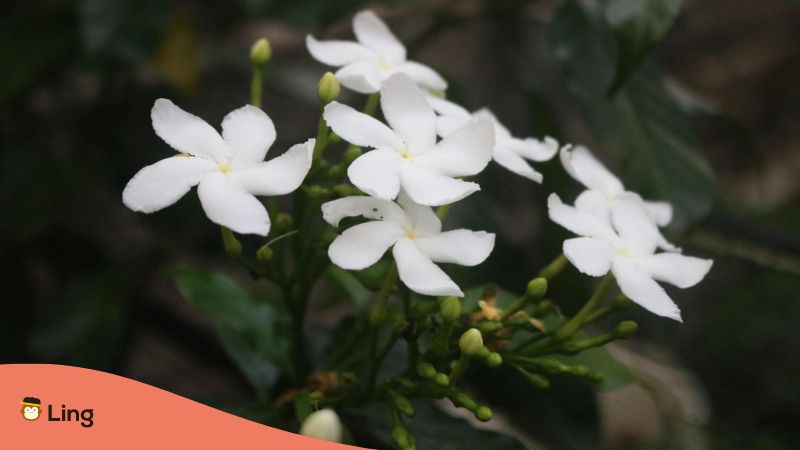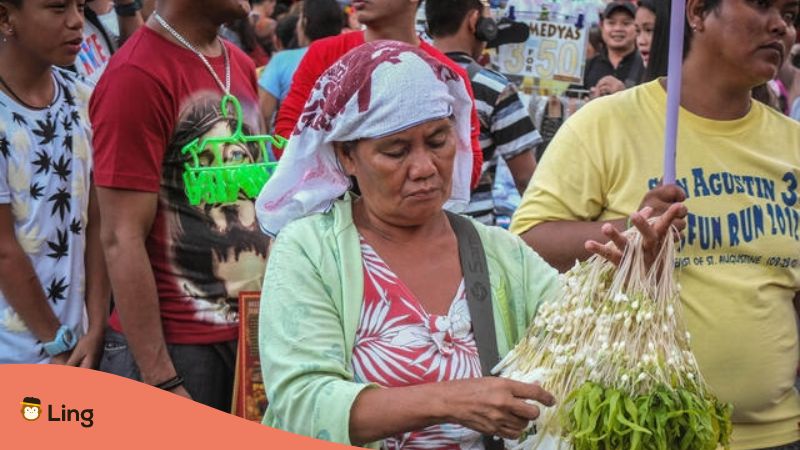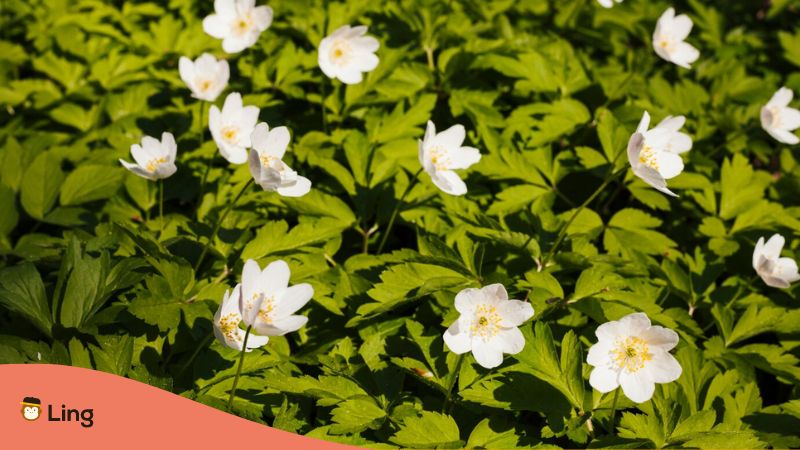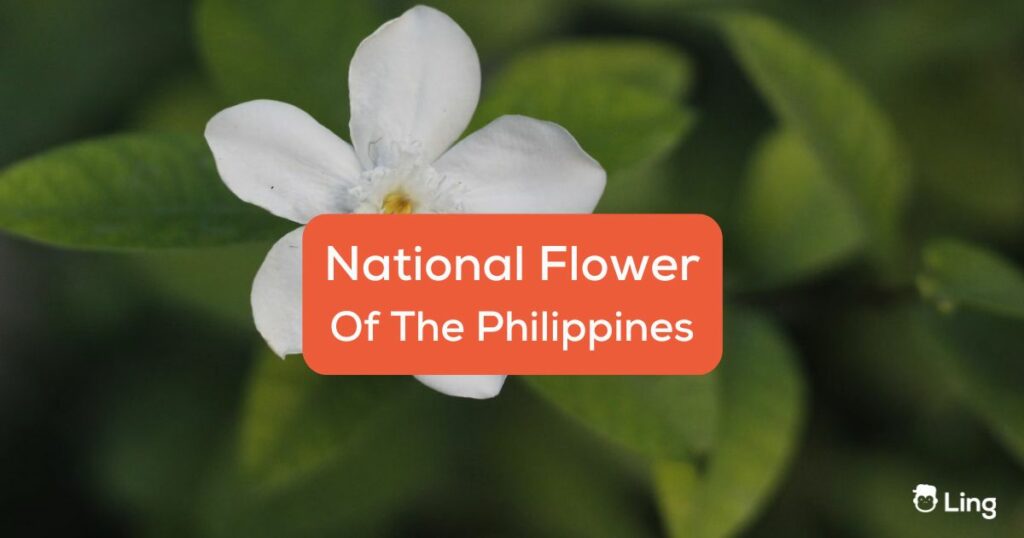Imagine a flower so sweet, so delicate, it could make your heart sing. That’s the Sampaguita, the national flower of the Philippines. Its heady scent hangs in the air, a constant reminder of sunny islands, vibrant festivals, and the warmth of the Filipino spirit.
As a Filipino, Sampaguita just feels like home. The smell makes me think of family, parties, and the simple joys of being Filipino. Let’s explore this amazing flower and learn Tagalog in the end! We’ll talk about what it means, where it comes from, and why Filipinos love it so much.
Table Of Contents
What Is Sampaguita?
The Sampaguita’s scientific name is Jasminum sambac or Arabian jasmine. Now, forget those big words. What you need to know is this: small white flowers with a huge, sweet smell. Seriously, close your eyes and imagine the most intoxicating floral scent—that’s the power of the Sampaguita!
These little star-shaped fragrant flowers pop up all year round, almost like they never take a break! They grow in adorable little bunches, but here’s the thing: they don’t generally bear seeds. Instead, you get more Sampaguita plants through cuttings, layering, marcotting – you know, the fancy gardener stuff.
Each tiny flower is surprisingly intricate. Picture a pure white cup, about 2 to 3 centimeters across (that’s 0.79 to 1.18 inches), with 5 to 9 delicate petals fanning out. Science is kinda cool sometimes, right?
Now, get this: the Sampaguita, this icon of the Philippines? It’s not even from here originally! History buffs think it came from India way back when, maybe even the Himalayas. Can you imagine? Some adventurous traveler brought it over, and the Filipino people were like, “Okay, we’re obsessed.”
So, how’d a foreign flower become the national symbol of the Philippines? Well, that’s a story worth telling, and guess what? We’re diving into it next!

Why Is Sampaguita The National Flower Of The Philippines?
So, way back in 1934, American Governor-General Frank Murphy took one look at the Sampaguita and was like, “Whoa, this flower gets it.” It wasn’t just how pretty it was—there was something about it that just screamed “Philippines!” So, he went ahead and made it the official national flower of the Philippines. And honestly, the guy had a point.
But why is this little flower such a big deal? Well, it turns out the Sampaguita symbolizes a whole bunch of things that are super important to us Filipinos:
- Purity (Kalinisan): You see those perfect white petals? They’re not just about looking clean. They also remind us to be good people on the inside, to have kind hearts and honest intentions.
- Simplicity (Kasimplehan): We don’t need a lot of fancy stuff to be happy. The Sampaguita, with its simple, beautiful look, reminds us of that. It’s about finding joy in the little things – a good laugh with friends, a delicious home-cooked meal, and the feeling of family around you.
- Humility (Kababaang-loob): You’ll seldom catch a Filipino bragging, even if they do something awesome. It’s all about staying grounded, just like the Sampaguita. It doesn’t need to show off; its beauty speaks for itself.
- Strength (Lakas): Those blossoms might seem delicate, but guess what? They’re tougher than they look! They can handle all kinds of weather. That’s just like the Filipino spirit – we might face some storms, but we always bounce back.
- Fidelity (Katapatan): We’re all about loyalty, whether it’s to our family, our friends, or our country. The Sampaguita symbolizes that unbreakable bond, like those petals all strung together in a garland.
- Hope (Pag-asa): Even when things get tough, the Sampaguita’s sweet smell reminds us that things will get better. You know how Filipinos are – we always believe in brighter days ahead!
Have you noticed those Tagalog words? You can learn more about them with the Ling app! This language-learning app will help you master 60+ languages in a fun, effective, and, most importantly, easy way! You can get it from Google Play and the App Store and use it for free!
Sampaguita In Filipino Traditions
Now that you know where the Sampaguita came from and what it symbolizes, let’s get into the fun stuff. The question is: How is it practically part of the air we breathe here in the Philippines?
Religious Offerings
You won’t find a Catholic church in the Philippines without a touch of Sampaguita. We drape garlands over statues of saints, especially the Virgin Mary. Sampaguita rosaries are also common, and the tiny dried buds are woven into the beads. It’s a way to make our prayers feel extra special, the sweet scent carrying them upwards.
Leis And Garlands (Lei)
Nothing says Mabuhay! (welcome) or “Congratulations!” quite like a Sampaguita lei. Think of them as giant, fragrant hugs! We give them to honored guests, politicians, and even beauty pageant winners. When a loved one returns home from overseas, expect a lei—that’s when the homesickness hits hardest, and the Sampaguita brings a piece of the Philippines to them.
Weddings And Festivals
Can you picture a Filipino wedding tradition without Sampaguita? I sure can’t! Brides usually carry small, delicate bouquets, and their hair might even be adorned with tiny buds. And during fiestas? Forget confetti – the dancers wear vibrant costumes decorated with Sampaguita. Even the floats smell incredible!
Sampaguita On The Streets
You don’t have to go to a fancy shop to find Sampaguita in the Philippines. Sampaguita vendors are commonly found at busy intersections, especially when the traffic lights turn red. You’ll often see them, sometimes children, approaching cars with Sampaguita leis or small garlands designed to hang as car fresheners. For just about 20 pesos (that’s around $0.20), you can bring a touch of the Philippines into your day.

Sampaguita In Art And Culture
The Sampaguita’s impact reaches far beyond its looks or scent. In the Philippines, Sampaguita has become a symbol of everything Filipino!
Filipino Art
Paintings of Sampaguita vendors, with their wide baskets brimming with blooms, are classics. The beauty of the Sampaguita flower is not just about the flower itself but what it represents—the hard work and warmth of ordinary Filipinos. You’ll also find modern sculptures inspired by the shape and simplicity of the blossoms.
Literature
Filipino poets have written about Sampaguita for centuries! Some compare its fragrance to first love. Others use it as a symbol of the Philippines itself or that feeling of longing for home when you’re far away.
Music
Who hasn’t heard the famous Filipino kundiman “Sampaguita”? But there are so many more! Folk songs that talk about young women as pure as Sampaguita or love songs where the singer promises to bring their beloved garlands of the flower. It seems our musicians are just as smitten as the rest of us!
What Are The Practical Uses Of Sampaguita?
So you know the Sampaguita is gorgeous and represents everything awesome about being Filipino. But Sampaguita has all sorts of practical uses you might not expect. Here are some of them:
For Perfume
Ever wonder what gives fancy perfumes that exotic, tropical scent? Yep, they have the power of Sampaguita essential oil! Perfume makers carefully extract the oil from the blossoms, capturing that intense, sweet fragrance that adds a unique, unforgettable layer to perfumes, which makes them smell like a luxurious island getaway.
For Traditional Medicine
While modern medicine is always important, Filipinos have used Sampaguita in traditional remedies for centuries. Here’s where things get interesting: some folks crush the leaves and apply them as a poultice to soothe headaches or help reduce fevers. Others brew the dried flowers into a calming, fragrant tea that’s believed to ease anxiety and promote relaxation.
For Filipino Gardens
Sampaguita plants are super low-maintenance, especially in our tropical climate. Pop them in a spot with plenty of sunshine, give them regular water, and they’ll reward you with an explosion of blooms.

Other Jasmine Varieties In The Philippines
Sure, the Sampaguita might be the queen of Filipino flowers, but it’s not the only jasmine in town! Turns out, we’ve got a few other gorgeous varieties that deserve some attention, too:
- Angelwing Jasmine (Jasminum nitidum): This one’s a showstopper! It has big, shiny leaves and clusters of white, star-shaped flowers that have a slightly different, but still delightful, fragrance. They look amazing climbing up a trellis or spilling over a wall.
- Downy Jasmine (Jasminum multiflorum): This variety’s buds are covered in soft, white hairs, which makes it super unique. It has the classic sweet jasmine scent and would look beautiful woven into a garland.
- Yellow Jasmine (Jasminum humile): Want a pop of color? This one’s for you! Its bright yellow flowers are smaller than the Sampaguita, but they add a cheerful vibe to any garden.
- Forest Jasmine (Jasminum auriculatum): This jasmine is slightly different because its flowers have a unique, needle-like shape and milder fragrance. It’s still a beautiful addition and can add a touch of the unusual to a flower collection.
Remember, these are just a few examples! The Philippines is a biodiversity hotspot, so there might be other local jasmine varieties depending on where you are.
And while they’re all gorgeous, these other jasmine flowers don’t have the same symbolic power as the Sampaguita. Our national flower is different from other national flowers because of its history and how deeply it’s connected to our Filipino identity.
Useful Words And Phrases You Can Use
Ready to impress your Filipino friends with some cool Tagalog flower power? Here are a few words and phrases that’ll help you talk about all things Sampaguita:
| English | Tagalog | When To Use It |
|---|---|---|
| The Sampaguita really smells so good! | Ang bango talaga ng Sampaguita! | Expressing admiration for the fragrance of the Sampaguita. |
| Sampaguita reminds me of the Philippines. | Ang Sampaguita ay nagpapaalala sa akin ng Pilipinas. | Expressing personal connections to the flower and homeland. |
| Give Sampaguita to… | Bigyan mo ng Sampaguitan si… | Asking someone to give Sampaguita to another person. |
| Here is the Sampaguita for you. | Heto ang Sampaguita para sayo. | Giving Sampaguita as a gesture of affection or respect. |
| How much is one string of Sampaguita? | Magkano ang isang tali ng Sampaguita? | Wanting to buy Sampaguita and inquiring about the price. |
| My Sampaguita plant has bloomed! | Namulaklak na ang halaman ko ng Sampaguita! | Sharing the joy of your Sampaguita plant flowering. |
| I’d like to buy some Sampaguita. | Pabili ng Sampaguita. | Directly stating your intention to purchase Sampaguita. |
| May I have some of your Sampaguita, please? | Pahingi naman po ng Sampaguita nyo. | Politely requesting Sampaguita from someone. |
| Sampaguita is the national flower of the Philippines. | Sampaguita ang pambansang bulaklak ng Pilipinas. | When sharing facts about the Philippines with others. |
One Last Thing About Sampaguita
Okay, forget the whole flower power speech. What the Sampaguita really makes you think about is the Philippines. You smell it, and boom—you picture crowded markets, music playing, and people smiling, even if you’ve never been there yourself. Yeah, it’s that kind of flower.
So, next time you spot some Sampaguita or even just smell that amazing scent, don’t just admire how pretty it is. Let it spark something! Maybe you’ll want to look up other Philippine national symbols, learn new Tagalog phrases to connect with Filipinos, or check out photos of the amazing festivals where Sampaguita is everywhere. The Sampaguita, this little flower, being the national flower of the Philippines, is a reminder that there’s an amazing culture waiting to be explored.



































































